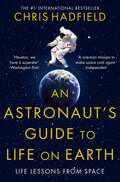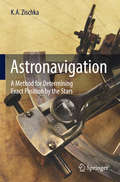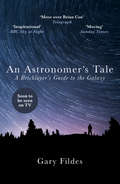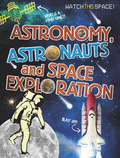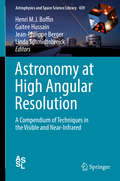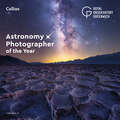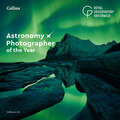- Table View
- List View
Astrodynamics Network AstroNet-II: The Final Conference (Astrophysics and Space Science Proceedings #44)
by Gerard Gómez Josep J. MasdemontThese are the proceedings of the "AstroNet-II International Final Conference". This conference was one of the last milestones of the Marie-Curie Research Training Network on Astrodynamics "AstroNet-II", that has been funded by the European Commission under the Seventh Framework Programme.The aim of the conference, and thus this book, is to communicate work on astrodynamics problems to an international and specialised audience. The results are presented by both members of the network and invited specialists. The topics include: trajectory design and control, attitude control, structural flexibility of spacecraft and formation flying.The book addresses a readership across the traditional boundaries between mathematics, engineering and industry by offering an interdisciplinary and multisectorial overview of the field.
Astronaut Academy: Inquiry-Based Science Lessons for Advanced and Gifted Students in Grades 2-3
by Jason S. McIntoshThe word "astronaut" comes from the Greek words meaning "star sailor," and that is exactly what students will become in Astronaut Academy. This 30-lesson interdisciplinary science unit: Is designed to teach high-ability second and third graders how to think like real-world astronauts. Requires students to explore the far regions of the solar system. Was designed using the research-based Integrated Curriculum Model. Features challenging problem-based learning tasks and engaging resources. Includes detailed teacher instructions and suggestions for differentiation. In this unit, students study the concept of exploration, journey to each planet, and create their own space station, all while acquiring scientific knowledge and habits, including how to follow the scientific method and properly conduct research and experiments. Suggestions and guidance are included on how teachers can adjust the rigor of learning tasks based on students' interests and needs. Grades 2-3 Recipient of the 2020 NAGC Curriculum Award
Astronaut Academy: Inquiry-Based Science Lessons for Advanced and Gifted Students in Grades 2-3
by Jason S. McIntoshThe word "astronaut" comes from the Greek words meaning "star sailor," and that is exactly what students will become in Astronaut Academy. This 30-lesson interdisciplinary science unit: Is designed to teach high-ability second and third graders how to think like real-world astronauts. Requires students to explore the far regions of the solar system. Was designed using the research-based Integrated Curriculum Model. Features challenging problem-based learning tasks and engaging resources. Includes detailed teacher instructions and suggestions for differentiation. In this unit, students study the concept of exploration, journey to each planet, and create their own space station, all while acquiring scientific knowledge and habits, including how to follow the scientific method and properly conduct research and experiments. Suggestions and guidance are included on how teachers can adjust the rigor of learning tasks based on students' interests and needs. Grades 2-3 Recipient of the 2020 NAGC Curriculum Award
Astronautical Research 1971: Proceedings of the 22nd Congress of the International Astronautical Federation Brussels, 20–25 September 1971
by L. G. Napolitano P. Contensou W. F. HiltonThe International Astronautical Federation is the only professional society in the field of aerospace engineering and Sciences which brings together specialists of all countries interested in the exploration and peaceful exploitation of space. At its annual Congresses a large number of invited and/or carefully selected con tributed papers are presented which cover a wide variety of topics and are distributed over a number of sessions, each one being organized by two leading scientists who later chair the session itself. Each year the selection of specific topics to be dealt with. is dictated either by significant new progress achieved in some sectors or by new developments and trends which are liable to influence substantially the objectives toward which space research and/or application of space technology will be oriented in the immediate future. A second rigorous screening, performed with the help of the Session Chairmen and carried out according to the same criteria identifies finally the papers which are published in the Proceedings. The outcome of all this is reliable and authoritative information as to the actual status and future trends of space activities, both from the research point of view and from the point of view of u~ilization and/or application.
Astronautical Research 1972: Proceedings of the 23rd Congress of the International Astronautical Federation Vienna, 8–15 October 1972
by L. G. Napolitano P. Contensou W. F. HiltonSpace scientists and engineers belonging to the professional societies associated with the International Astronautical Federation gathered together in Vienna to hold the Federation's 23rd Congress. A selected number of papers and critical surveys that were presented and debated at this Congress and which span the widely diversified field of astonautics are collected in the present Proceedings, together with a number of summaries of Round Table Discussions andjor Forum Sessions. As its predecessors in the series, Astronautical Research 1972 constitutes an indispensable reference for several groups of people: those who are actively engaged in astronautics; those who are interested in following and assessing, year by year, the developments in astronautics, its progress, its new directions in research; and those who are concerned with its many applications. Space science and technology are bound to play an increasing role in the immediate future, now that greater effort is being devoted to the exploitation of their relevance to other fields of human activity. Problems posed by the scarcity of earth resources and by their inadequate management, pollution problems, problems created by man's indiscriminate and often irresponsible action in vital sectors of the biosphere can be tackled and successfully alleviated, if not solved, by means of the soft and hard advanced technology developed for space systems.
Astronautics: Summary and Prospects
by Anatoli I. Kiselev Alexander A. Medvedev Valery A. MenshikovThe authors, leading representatives of Russian space research and industry, show the results and future prospects of astronautics at the start of the third millennium. The focus is on the development of astronautics in Russia in the new historical and economic conditions. The text spotlights the basic trends in space related issues before moving on to describe the possibilities of the wide use of space technologies and its numerous applications such as navigation and communication, space manufacturing, and space biotechnology. The book contains a large amount of facts described in a way understandable without specialist knowledge. The text is accompanied by many photographs, charts and diagrams, mostly in color.
Astronautics: The Physics of Space Flight
by Ulrich WalterThis introductory text covers all the key concepts, relationships, and ideas behind spaceflight and is the perfect companion for students pursuing courses on or related to astronautics. As a crew member of the STS-55 Space Shuttle mission and a full professor of astronautics at the Technical University of Munich, Ulrich Walter is an acknowledged expert in the field. This book is based on his extensive teaching and work with students, and the text is backed up by numerous examples drawn from his own experience. With its end-of-chapter examples and problems, this work is suitable for graduate level or even undergraduate courses in spaceflight, as well as for professionals working in the space industry. This third edition includes substantial revisions of several sections to extend their coverage. These include both theoretical extensions such as the study of relative motion in near-circular orbits, and more practical matters such as additional details about jet-engine and general rocket performance. New sections address regularized equations of orbital motion and their algebraic solutions and also state vector propagation; two new chapters are devoted to orbit geometry and orbit determination and to thermal radiation physics and modelling.
The Astronaut's Cookbook: Tales, Recipes, and More
by Charles T. Bourland Gregory L. VogtAstronauts, cosmonauts, and a very limited number of people have experienced eating space food due to the unique processing and packaging required for space travel. This book allows anyone with a normal kitchen to prepare space food. Since some of the processing such as freeze dehydration, and packaging cannot be accomplished in the normal kitchen, many of the recipes will not produce the food that would be launched in space, but will prepare food similar to what the astronauts would eat after they had added the water to the food in space. Many of the space foods are prepared to the point of ready to eat, and then frozen and freeze dried. Food preparation in this book stops at the point of ready to eat before the freezing and dehydrating takes place. Recipes in this book are extracted from the NASA food specifications and modified for preparation in a normal kitchen. The book will contain the following chapters: Introduction, Appetizers, Beverages, Bread and Tortillas, Cookies, Sandwiches, Desserts, Main Dishes, Soups and Salads, Vegetables, and Future Space Foods. Interesting tidbits of space food history will be spread throughout the book. Examples like; did NASA invent Tang?, who was the first person to eat in space?, the Gemini sandwich fiasco, why there is no alcohol in U.S. space food systems, astronauts favorite food, etc.
Astronauts For Hire: The Emergence of a Commercial Astronaut Corps (Springer Praxis Books)
by Erik Seedhouse'Astronauts For Hire' is a comprehensive and authoritative study of the increasing need for commercial astronauts. Erik Seedhouse provides unique insights into the burgeoning new field of commercial space operation and the individuals who will run these missions. Section I begins by describing how Astronauts for Hire (A4H) was created in 2010 by Brian Shiro, a highly qualified NASA astronaut candidate, and a group of other astronaut candidates. Erik introduces A4H's vision for opening the space frontier to commercial astronauts and describes the tantalizing science opportunities offered when suborbital and orbital trips become routine. Section II describes the vehicles astronauts will use. Anticipation is on the rise for the new crop of commercial suborbital and orbital spaceships that will serve the scientific and educational market. These reusable rocket-propelled vehicles are expected to offer quick, routine, and affordable access to the edge of space, along with the capability to carry research and educational crew members. The quick turnaround of these vehicles is central to realizing the profit-making potential of repeated sojourns by astronauts to suborbital and orbital heights. Section III describes the various types of missions this new corps of astronauts will fly and who will hire them. For example, suborbital flights may be used to do high altitude astronomy, life science experiments, and microgravity physics. This section continues with an examination of the types of missions that will accelerate human expansion outward, to Exploration Class missions through lunar bases, the establishment of interplanetary spaceports, and outposts on the surface of Mars. Along the way it describes the tasks commercial astronauts will perform, ranging from mining asteroids to harvesting helium.
An Astronaut's Guide to Life on Earth: What Going To Space Taught Me About Ingenuity, Determination, And Being Prepared For Anything
by Chris HadfieldColonel Chris Hadfield has spent decades training as an astronaut and has logged nearly 4,000 hours in space. During this time he has broken into a Space Station with a Swiss army knife, disposed of a live snake while piloting a plane, been temporarily blinded while clinging to the exterior of an orbiting spacecraft, and become a YouTube sensation with his performance of David Bowie's 'Space Oddity' in space. The secret to Chris Hadfield's success – and survival – is an unconventional philosophy he learned at NASA: prepare for the worst – and enjoy every moment of it.In his book, An Astronaut's Guide to Life on Earth, Chris Hadfield takes readers deep into his years of training and space exploration to show how to make the impossible possible. Through eye-opening, entertaining stories filled with the adrenaline of launch, the mesmerizing wonder of spacewalks and the measured, calm responses mandated by crises, he explains how conventional wisdom can get in the way of achievement – and happiness. His own extraordinary education in space has taught him some counter-intuitive lessons: don't visualize success, do care what others think, and always sweat the small stuff.You might never be able to build a robot, pilot a spacecraft, make a music video or perform basic surgery in zero gravity like Colonel Hadfield. But his vivid and refreshing insights in this book will teach you how to think like an astronaut, and will change, completely, the way you view life on Earth – especially your own.
Astronavigation: A Method for Determining Exact Position by the Stars
by K. A. ZischkaThis book acts as a manual for the ancient methods of navigating by the stars, which continue to provide the sailor or pilot with a timeless means of determining location. Despite the prevalence of GPS, a comprehensive set of formulae that can be evaluated on any inexpensive scientific calculator in the event of a catastrophic software or systems failure is a vital failsafe. It also serves as a living link to centuries of explorers from centuries past. Beginning with the basics of positional astronomy, this guide moves on to the more complex math necessary to understand the ephemerides, tables showing the future positions of the stars and planets. These astronomical almanacs were the satellite navigation of their day. The objective of this book is twofold: to provide the reader with a concise, comprehensible manual on positional astronomy as it applies to astro-navigation and to furnish the concise algorithms for finding the position of the Sun and various navigational stars at any given instant.In a world where too many mariners and aeronauts rely solely on technology and are vulnerable to solar flares, electrical issues, and the like, this knowledge can be a life-saving backup, not to mention a fascinating study in its own rights. Included is an exact mathematical way to determine your position in the air or on the sea far more quickly and accurately than by using the old celestial navigational method, without even needing to know or understand the underlying mathematics. There is even a section that teaches how to measure the azimuth of a star using an analog wrist watch so if a sextant gets damaged, locating position is still possible. This book offers mathematicians and adventurers a way to determine position when the skies go dark.The U.S. Navy has recently realized that their electronic navigation systems are vulnerable to cyberattack, and as a result has instructed the Naval Academy to begin teaching celestial navigation again.
An Astronomer's Tale: A Bricklayer’s Guide to the Galaxy
by Gary FildesA Bricklayer's Guide to the Galaxy . . . The inspirational memoir of a former brickie who followed his passion for the stars and built his own observatory. Perfect for readers of Robert Macfarlane, Helen Macdonald and James Rebanks - as well as fans of Brian Cox and the BBC’s Sky at Night Gary Fildes left school at sixteen, got a trade like most of his mates and was soon married with four kids. His life seemed set. But he had a secret. Something he only practised late at night with a few like-minded friends. Then one day, middle age approaching alarmingly, he acted on his lifelong passion. He finally came out. As an astronomer.Today, Gary is the founder and lead astronomer of Kielder Observatory, one of the top ten stargazing sites in the world, which he also helped to build. Situated in the beautiful forests of Kielder, Northumberland, within Europe’s largest protected dark sky park, it offers some of the UK's most spectacular views of stars, planets and galaxies.An Astronomer’s Tale is Gary’s inspirational story: part memoir, part nature writing, part seasonal guide to the night sky. It is a book brimming with passion; and at a time when the world is captivated by space, it will leave you ready to get out there and explore the wonders of the skies for yourself.
Astronomical Optics and Elasticity Theory: Active Optics Methods (Astronomy and Astrophysics Library)
by Gérard René LemaitreAstronomical Optics and Elasticity Theory provides a very thorough and comprehensive account of what is known in this field. After an extensive introduction to optics and elasticity, the book discusses variable curvature and multimode deformable mirrors, as well as, in depth, active optics, its theory and applications. Further, optical design utilizing the Schmidt concept and various types of Schmidt correctors, as well as the elasticity theory of thin plates and shells are elaborated upon. Several active optics methods are developed for obtaining aberration corrected diffraction gratings. Further, a weakly conical shell theory of elasticity is elaborated for the aspherization of grazing incidence telescope mirrors. The very didactic and fairly easy-to-read presentation of the topic will enable PhD students and young researchers to actively participate in challenging astronomical optics and instrumentation projects.
Astronomical Photometry: Past, Present, and Future (Astrophysics and Space Science Library #373)
by Eugene F. F. Milone and C. SterkenThis book will bring together experts in the field of astronomical photometry to discuss how their subfields provide the precision and accuracy in astronomical energy flux measurements that are needed to permit tests of astrophysical theories. Differential photometers and photometry, improvements in infrared precision, the improvements in precision and accuracy of CCD photometry, the absolute calibration of flux, the development of the Johnson UBVRI photometric system and other passband systems to measure and precisely classify specific types of stars and astrophysical quantities, and the current capabilities of spectrophotometry, and polarimetry to provide precise and accurate data, will all be discussed in this volume. The discussion of `differential’ or `two-star’ photometers will include those developed for planetary as well as stellar photometry and will range from the Princeton polarizing photometer through the pioneering work of Walraven to the differential photometers designed to measure the ashen light of Venus and to counter the effects of aurorae at high latitude sites; the last to be discussed will be the Rapid Alternate Detection System (RADS) developed at the University of Calgary in the 1980s.
Astronomical Spectroscopy for Amateurs (The Patrick Moore Practical Astronomy Series)
by Ken M. HarrisonAstronomical Spectroscopy for Amateurs is a complete guide for amateur astronomers who are looking for a new challenge. After a brief overview of the development of spectroscopes and an introduction to the theory of stellar spectra, the book goes on to examine the various types of spectroscopes available to amateurs. Next, practical sections address all aspects of setting-up and using various types of commercially-available and home-built spectroscopes. A final part gives detailed instructions for the design and construction of three different spectroscopes, along with the necessary design theory (minimal math). The home-made spectroscopes have performance capabilities near or equal to commercial units but are constructed using basic hand tools for a fraction of the cost! This up-to-date practical spectroscopy book will enable amateur astronomers to develop the skills and equipment needed to prepare scientifically acceptable spectra data, and to make a valuable contribution to ProAm projects.
Astronomie spatiale infrarouge, aujourd'hui et demain Infrared space astronomy, today and tomorrow: 3-28 August 1998 (Les Houches - Ecole d'Ete de Physique Theorique #70)
by F. Casoli J. Lequeux F. DavidAstronomische Navigation: Ein Lehr- und Handbuch für Studenten und Praktiker
by Werner F. SchmidtDer Autor führt in einer sehr lebendigen Art in die Probleme und Grundlagen der Astronomischen Navigation ein, so daß es schwer fällt, das einmal angefangene Buch wieder aus der Hand zu legen. Anhand von Aufgaben (und der im Anhang angegebenen entsprechenden Lösungen) ist der Leser jederzeit in der Lage, selbst zu kontrollieren, inwieweit er den abgehandelten Stoff in sich aufgenommen hat. Die Gliederung des Buches entspricht der, wie sie in Unterrichtsveranstaltungen zur Astronomischen Navigation - sei es nun in Kursen für Segler oder in Veranstaltungen für angehende Nautiker - üblicherweise auch zur Anwendung kommt.
Astronomische Navigation: Ein Lehr- und Handbuch für Studenten und Praktiker
by Werner F. SchmidtAus den Besprechungen: "Der Autor führt in einer sehr lebendigen Art in die Probleme und Grundlagen der Astronomischen Navigation ein, so daß es schwer fällt, das einmal angefangene Buch wieder aus der Hand zu legen. Anhand von Aufgaben (und der im Anhang angegebenen entsprechenden Lösungen) ist der Leser jederzeit in der Lage selbst zu kontrollieren, inwieweit er den abgehandelten Stoff in sich aufgenommen hat. Die Gliederung des Buches entspricht der, wie sie in Unterrichtsveranstaltungen zur Astronomischen Navigation - sei es nun in Kursen für Segler oder in Veranstaltungen für angehende Nautiker - üblicherweise auch zur Anwendung kommt. ..." #Ortung und Navigation#1 "... seiner positiven Antwort kann man nach Lektüre des Buches bereitwillig zustimmen, macht doch allein das danach aufgefrischte oder ergänzte Wissen den Hobby- oder Berufsnautiker selbstsicherer bei der Ausführung seiner Aufgaben. ...Gründliche Bearbeitung der einzelnen Gebiete sowie gute und reichliche Illustrationen fördern die Verständlichkeit und machen zusammen mit den in jedem Kapitel enthaltenen Übungsaufgaben dieses Buch auch oder gerade für den Praktiker anregend. Mit drei aufgezeigten Verfahren zur Berechnung eines Standortes ist jedem Leser Spielraum gegeben, sein Wissen zu prüfen oder zu ergänzen, wobei die Tafeln im Anhang weitere Nachschlagewerke erübrigen." #Naturwissenschaften#2
Astronomy, Astronauts and Space Exploration: Astronomy Astronauts And Space Exploration (Watch This Space)
by Clive GiffordJust how many stars are there? What exactly is a shooting star? And what don't you know about the evolution of our night skies? Find out the answer to these questions and more exciting information about searching for other life forms, about fireballs, comets and future space travel in this exciting series 'Watch this Space' series!Perfect for the new curriculum, this fascinating title is packed full of information, number-based awe-inpiring facts and figures.
Astronomy at High Angular Resolution: A Compendium of Techniques in the Visible and Near-Infrared (Astrophysics and Space Science Library #439)
by Henri M. J. Boffin Gaitee Hussain Jean-Philippe Berger Linda SchmidtobreickThis book offers an essential compendium of astronomical high-resolution techniques. Recent years have seen considerable developments in such techniques, which are critical to advances in many areas of astronomy. As reflected in the book, these techniques can be divided into direct methods, interferometry, and reconstruction methods, and can be applied to a huge variety of astrophysical systems, ranging from planets, single stars and binaries to active galactic nuclei, providing angular resolution in the micro- to tens of milliarcsecond scales. Written by experts in their fields, the chapters cover adaptive optics, aperture masking imaging, spectra disentangling, interferometry, lucky imaging, Roche tomography, imaging with interferometry, interferometry of AGN, AGN reverberation mapping, Doppler- and magnetic imaging of stellar surfaces, Doppler tomography, eclipse mapping, Stokes imaging, and stellar tomography. This book is intended to enable a next generation of astronomers to apply high-resolution techniques. It informs readers on how to achieve the best angular resolution in the visible and near-infrared regimes from diffraction-limited to micro-arcsecond scales.
Astronomy in the Near-Infrared - Observing Strategies and Data Reduction Techniques (Astrophysics and Space Science Library #467)
by Jochen HeidtNear-infrared astronomy has become one of the most rapidly developing branches in modern astrophysics. Innovative observing techniques, near-infrared detectors with quantum efficiencies in excess of 90%, highly specialised instruments as well as advanced data reduction techniques have allowed major breakthroughs in various areas like exoplanets, star-forming regions, the supermassive black hole in the Galactic center, and the high-redshift Universe. In this book, the reader will be introduced to the basic concepts of how to prepare near-infrared observations with maximized scientific return. Equal weight is given to all aspects of the data reduction for both - imaging and spectroscopy. Information is also provided on the state of the art instrumentation available and planned, on detector technology or the physics of the atmosphere, all of which influence the preparation and execution of observations and data reduction techniques. The beginner but also the expert will find a lot of information in compact form which is otherwise widely dispersed across the internet or other sources.
Astronomy Photographer of the Year: Collection 11
by Royal Observatory Greenwich Collins AstronomyA stunning ebook with clear navigation for admirers of astrophotography. This ebook has been built to W3C accessibility guidelines and will work with text to speech. The layout has been redesigned with clear navigation links to each of the competition entries within the Maps section. It is compatible with all ereading apps and devices.
Astronomy Photographer of the Year: Collection 12
by Royal Observatory Greenwich Collins AstronomyA stunning ebook with clear navigation for admirers of astrophotography. This ebook has been built to W3C accessibility guidelines and will work with text to speech. The layout has been redesigned with clear navigation links to each of the competition entries within the Maps section. It is compatible with all ereading apps and devices.
Astronomy’s Quest for Sharp Images: From Blurred Pictures to the Very Large Telescope (Astronomers' Universe)
by Pierre LénaSince the 1960s, astrophysical discoveries have blossomed, due to the emergence of powerful and new observational tools. Among them, a fantastic improvement of the sharpness of astronomical images, obtained with ground based optical telescopes, has been the result of two revolutions: adaptive optics and optical interferometry. Written for a general audience, interwoven with fascinating details about the evolution of vision and optics, this book tells a personal story of these revolutions in observational astronomy, born two centuries ago and blossoming in the past fifty years. With the construction of the Very Large Telescope in Chile, Europe played a leading role where young scientists, joining creative astronomers and engineers, have developed a superb creativity. Today, incredibly sharp images of exoplanetary systems and black hole environments are obtained and reveal new questions about Earth-like objects or fundamental physics. The author has been one of the actors of this adventure. His first-hand testimony is opening the future to new horizons.
Astrophysical Techniques
by C.R. KitchinLong used in undergraduate and introductory graduate courses, Astrophysical Techniques, Seventh Edition provides an accessible yet comprehensive account of the innovate instruments, detectors, and techniques employed in astronomy and astrophysics. Emphasizing the underlying unity of all astronomical observations, this popular textbook provides a coherent state-of-the-art account of the instruments and techniques used in current astronomy and astrophysics. Fully updated throughout, this seventh edition builds upon the sixth edition, covering improved techniques and cutting-edge methods in the field, as well as other exciting new developments in gravitational waves, dark matter and energy, the use of photonics, and astronomy education and outreach, in addition to further detailed discussions on the latest scientific instruments and individual detectors. The book is written in a very accessible manner, and most of the mathematics is accessible to those who have attended a mathematics course in their final years at school. Nevertheless, the treatment of the topics in general is at a sufficiently high level to be of use to those professionals seeking technical information in areas of astronomy with which they might not be completely familiar. Key Features: Details the instrumentation and theory of astronomical observations, including radio waves, gamma rays, cosmic rays, neutrinos, gravitational waves and dark matter and energy and more Presents the background theory and operating practice of state-of-the-art detectors and instruments Fully updated to contain the latest technology and research developments








